|
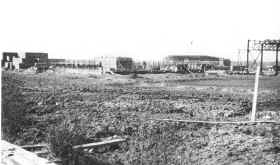
It was in 1937, when the Royal Air Force was expanding to meet the threat of Nazi aggression, that work began on the building of a new airfield near the historic village of Benson. On the 3rd of April 1939 No 150 Squadron moved into Benson from Boscombe Down to be joined a month later by No 103 Squadron from Abingdon. Both Squadrons were equipped with Fairey Battle aircraft and these were the first to fly at the new airfield under the command of Group Captain R T Leather AFC. Both Squadrons left Benson to move to France in September 1939 as components of the advanced air striking force. The Kings Flight moved to Benson in September of the same year. This first association was only a short one, with the Kings Flight being disbanded in 1942 to form the nucleus of 161 Squadron in 1942 at Newmarket.
|
|
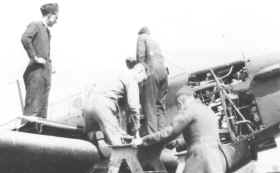 At the outbreak of war the station became No 12 Operational Training Unit, its first task being to train pilots, observers and air gunners in Fairey Battles and Avro Ansons for operations against the enemy. In 1940 these aircraft were superseded by Wellingtons. Among those trained on the station during this period was a Polish contingent. During the war RAF Benson was honoured by many distinguished visitors, including HM King George VI and HRH the Duke of Kent. Less welcome visitors were German aircraft which attacked the airfield on a number of occasions. Fortunately, little damage was caused and there was only one fatality. During one raid an air shelter received a direct hit but, since no warning had been received, it was empty. At the outbreak of war the station became No 12 Operational Training Unit, its first task being to train pilots, observers and air gunners in Fairey Battles and Avro Ansons for operations against the enemy. In 1940 these aircraft were superseded by Wellingtons. Among those trained on the station during this period was a Polish contingent. During the war RAF Benson was honoured by many distinguished visitors, including HM King George VI and HRH the Duke of Kent. Less welcome visitors were German aircraft which attacked the airfield on a number of occasions. Fortunately, little damage was caused and there was only one fatality. During one raid an air shelter received a direct hit but, since no warning had been received, it was empty.
|
|
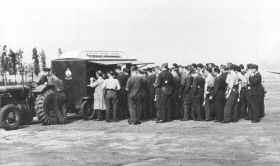 In 1941, RAF Benson was chosen as the home for an experimental Photographic Reconnaissance Unit which had been set up to test and develop new methods of carrying out photographic reconnaissance over enemy territory. Using Spitfire aircraft, pilots found that their speed enabled them to avoid interception and that their camouflage and height rendered them virtually invisible. Extra fuel tanks allowed them to fly deep into enemy territory and in fact, it was an aircraft from this unit, which was to spot the Bismarck near Bergen in May 1941. In 1941, RAF Benson was chosen as the home for an experimental Photographic Reconnaissance Unit which had been set up to test and develop new methods of carrying out photographic reconnaissance over enemy territory. Using Spitfire aircraft, pilots found that their speed enabled them to avoid interception and that their camouflage and height rendered them virtually invisible. Extra fuel tanks allowed them to fly deep into enemy territory and in fact, it was an aircraft from this unit, which was to spot the Bismarck near Bergen in May 1941.
|
|
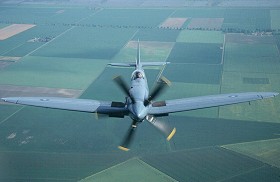 The advent of more advanced types of aircraft required the building of runways and these were completed in 1942, this work, however, caused the closing of the Old London Road and as a result, the Royal Engineers built the present road to Crowmarsh. With this development came the expansion of No PRU into No's 540, 541, 542, 543 and 544 Squadrons and the grouping of the station under Costal Command. Until the end of the war the special Spitfire and Mosquito aircraft of these squadrons ranged far and wide, from northern Norway to southern Italy and as far east as Vienna. Outstanding events during that period were: the photography of the Mohne, Eder and Sorpe Dams shortly after the attack by the Dambusters, a flight over Berlin 1943 when the pilot remained over the target for three quarters of an hour and obtained an almost complete mosaic of the city and the photography of the Tirpitz which was to lead to its destruction. A PRU Mosquito from Benson was the first aircraft to encounter a Me 262, the German jet propelled aeroplane. Although the encounter lasted for 20 minutes, the Mosquito was able to escape into the clouds and return home undamaged. The advent of more advanced types of aircraft required the building of runways and these were completed in 1942, this work, however, caused the closing of the Old London Road and as a result, the Royal Engineers built the present road to Crowmarsh. With this development came the expansion of No PRU into No's 540, 541, 542, 543 and 544 Squadrons and the grouping of the station under Costal Command. Until the end of the war the special Spitfire and Mosquito aircraft of these squadrons ranged far and wide, from northern Norway to southern Italy and as far east as Vienna. Outstanding events during that period were: the photography of the Mohne, Eder and Sorpe Dams shortly after the attack by the Dambusters, a flight over Berlin 1943 when the pilot remained over the target for three quarters of an hour and obtained an almost complete mosaic of the city and the photography of the Tirpitz which was to lead to its destruction. A PRU Mosquito from Benson was the first aircraft to encounter a Me 262, the German jet propelled aeroplane. Although the encounter lasted for 20 minutes, the Mosquito was able to escape into the clouds and return home undamaged.
|
|
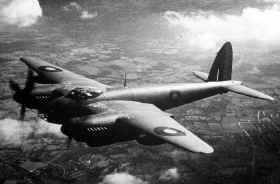 In 1944, a Mosquito from Benson was stripped of its photographic equipment and flew to Moscow in 4 hours, acting as a courier for the Moscow Conference. As a result of this flight, Mosquito's from RAF Benson were given the job of carrying diplomatic mail from Yalta and Potsdam conferences in 1945. In May 1945, four Mosquito's were delivered to Karachi within 13 hours of take-off from Benson, beating the previous record by over four hours. PRU Squadrons of Mosquito's continued to operate from Benson until the 1950's. Many changes occurred during the demobilization period and during this time No's 540 and 58 Squadrons were based here. For a time also No 54 Group Headquarters of flying Training Command was a lodger unit on the station. In addition, the King's Flight was reformed here in 1946. In 1953, the Station re-grouped under Transport Command, Two squadrons, No's 147 and 167, had responsibility for the ferrying of aircraft to all parts of the world including Germany, the Near and Far East. In 1944, a Mosquito from Benson was stripped of its photographic equipment and flew to Moscow in 4 hours, acting as a courier for the Moscow Conference. As a result of this flight, Mosquito's from RAF Benson were given the job of carrying diplomatic mail from Yalta and Potsdam conferences in 1945. In May 1945, four Mosquito's were delivered to Karachi within 13 hours of take-off from Benson, beating the previous record by over four hours. PRU Squadrons of Mosquito's continued to operate from Benson until the 1950's. Many changes occurred during the demobilization period and during this time No's 540 and 58 Squadrons were based here. For a time also No 54 Group Headquarters of flying Training Command was a lodger unit on the station. In addition, the King's Flight was reformed here in 1946. In 1953, the Station re-grouped under Transport Command, Two squadrons, No's 147 and 167, had responsibility for the ferrying of aircraft to all parts of the world including Germany, the Near and Far East.
|
|
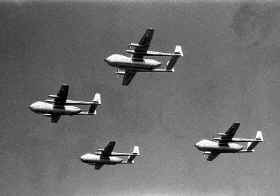 The Ferry Wing, as it was known at Benson, was disbanded in 1960 when squadrons became responsible for the collection and ferrying of their own aircraft. Meanwhile, plans for development of Benson in its new role, in the medium-range tactical air transport force, were put in hand. The first Whitworth-Armstrong Argosy arrived on 20th November 1961 and was the first of 6 which formed the Argosy Operational Conversion Unit. This unit subsequently moved to Thorney Island after training over 50 crews of the Argosy Force. The first Argosy Squadron to form at Benson was No 105, which subsequently moved to Aden to become part of the Middle East Air Forces. Later a second squadron, No 215 squadron, was formed and this moved to the Far East in July 1963. Two Argosy squadrons, No's 114 and 267, operated from Benson until the spring of 1970 as part of the medium-range transport force of Air Support Command. The Ferry Wing, as it was known at Benson, was disbanded in 1960 when squadrons became responsible for the collection and ferrying of their own aircraft. Meanwhile, plans for development of Benson in its new role, in the medium-range tactical air transport force, were put in hand. The first Whitworth-Armstrong Argosy arrived on 20th November 1961 and was the first of 6 which formed the Argosy Operational Conversion Unit. This unit subsequently moved to Thorney Island after training over 50 crews of the Argosy Force. The first Argosy Squadron to form at Benson was No 105, which subsequently moved to Aden to become part of the Middle East Air Forces. Later a second squadron, No 215 squadron, was formed and this moved to the Far East in July 1963. Two Argosy squadrons, No's 114 and 267, operated from Benson until the spring of 1970 as part of the medium-range transport force of Air Support Command.
|
|
 The continued presence of The Queens Flight and the arrival from Odiham of HQ 38 Group in 1972 - together with is associated unit of No 38 Group Tactical Communications Wing - meant that the level of activity at Benson remained high and this led to the extension and improvement of many of the facilities, both technical and domestic, on the station. In 1976, No 38 Group (by now in Strike Command) moved to Upavon, whilst the Tactical Communications Wing went to Brize Norton. To replace these units, the Support Command Signals Headquarters and the Radio Introduction Unit moved to Benson from Medmenham in 1977. SCSHQ remained at Benson until 1981. In January 1983, No 115 Squadron, the Andover Training Flight, the Andover Serving Flight and the Support Command Flight Checking Unit all moved to RAF Benson from RAF Brize Norton. The continued presence of The Queens Flight and the arrival from Odiham of HQ 38 Group in 1972 - together with is associated unit of No 38 Group Tactical Communications Wing - meant that the level of activity at Benson remained high and this led to the extension and improvement of many of the facilities, both technical and domestic, on the station. In 1976, No 38 Group (by now in Strike Command) moved to Upavon, whilst the Tactical Communications Wing went to Brize Norton. To replace these units, the Support Command Signals Headquarters and the Radio Introduction Unit moved to Benson from Medmenham in 1977. SCSHQ remained at Benson until 1981. In January 1983, No 115 Squadron, the Andover Training Flight, the Andover Serving Flight and the Support Command Flight Checking Unit all moved to RAF Benson from RAF Brize Norton.
|
|
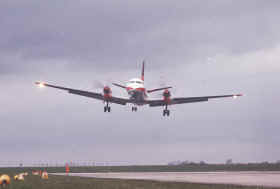 In 1986, the BAe 146 entered service with The Queens Flight, with the arrival of the first aircraft in May and the second in July, to be joined by a third aircraft at the end of 1990. The Support Command Flight Checking Unit disbanded at the beginning of 1987, its function and personnel transferred to No 115 Squadron which, in April 1988 celebrated it's 70th Anniversary. Undoubtedly the highlight of RAF Benson's 50th Anniversary Year - 1989 -was the selection of the station as the venue for the presentation of the Colour to the Royal Auxiliary Air Force by HM The Queen, the Air Commodore-in-Chief, on the 12th June 1989. With HRH the Duke of Edinburgh and numerous distinguished guests in attendance, the ceremonial took place in splendid weather and was a unique and memorable occasion. In 1986, the BAe 146 entered service with The Queens Flight, with the arrival of the first aircraft in May and the second in July, to be joined by a third aircraft at the end of 1990. The Support Command Flight Checking Unit disbanded at the beginning of 1987, its function and personnel transferred to No 115 Squadron which, in April 1988 celebrated it's 70th Anniversary. Undoubtedly the highlight of RAF Benson's 50th Anniversary Year - 1989 -was the selection of the station as the venue for the presentation of the Colour to the Royal Auxiliary Air Force by HM The Queen, the Air Commodore-in-Chief, on the 12th June 1989. With HRH the Duke of Edinburgh and numerous distinguished guests in attendance, the ceremonial took place in splendid weather and was a unique and memorable occasion.
|
|
A link with Benson's illustrious past was re-forged on the 17th November 1989 when a commemorative plaque in front of the gate-guardian Spitfire (replica) EN343 was unveiled by Sqn Ldr Gerry Fray, DFC RAF (Retd). EN343 was the Spitfire PRXI flown by Fg Off Fray on the morning of the 17th May 1943 to photograph the Mohne and Sorpe Dams after the successful raid by 617 Squadron. Since 1990 the role of RAF Benson has changed with an influx of new units to the station. In March 1992, No 60 Squadron formed with Wessex HC2 helicopters, returned to the UK mainland from service in Northern Ireland, Further units moved to the Station in July 1992 on the closure of RAF Abingdon, including the University of London Air Squadron, Oxford University Air Squadron and No 6 Air Experience Flight. The Mobile Catering Support Unit (MCSU) returned to RAF Benson, their home in the 70's, in November 1992. The unit provides a training facility along with 3 Air Combat Support Units. The units are air portable and each is capable of feeding up to 500 personnel with fresh rations under field conditions.
|